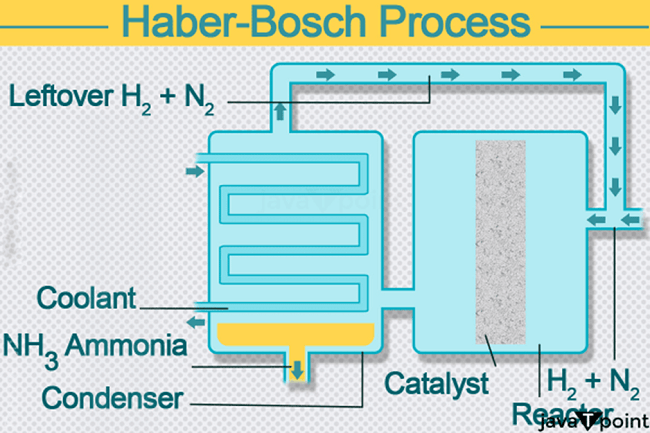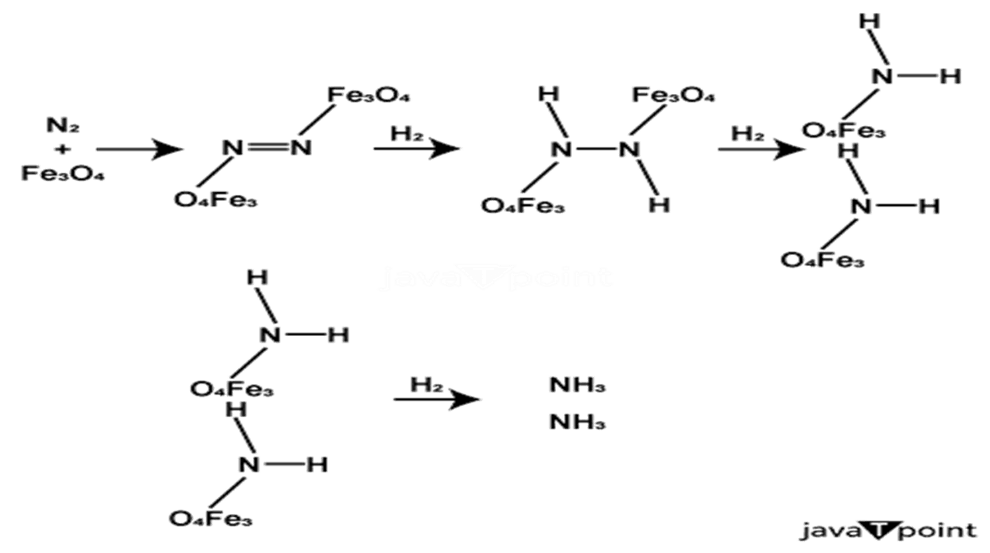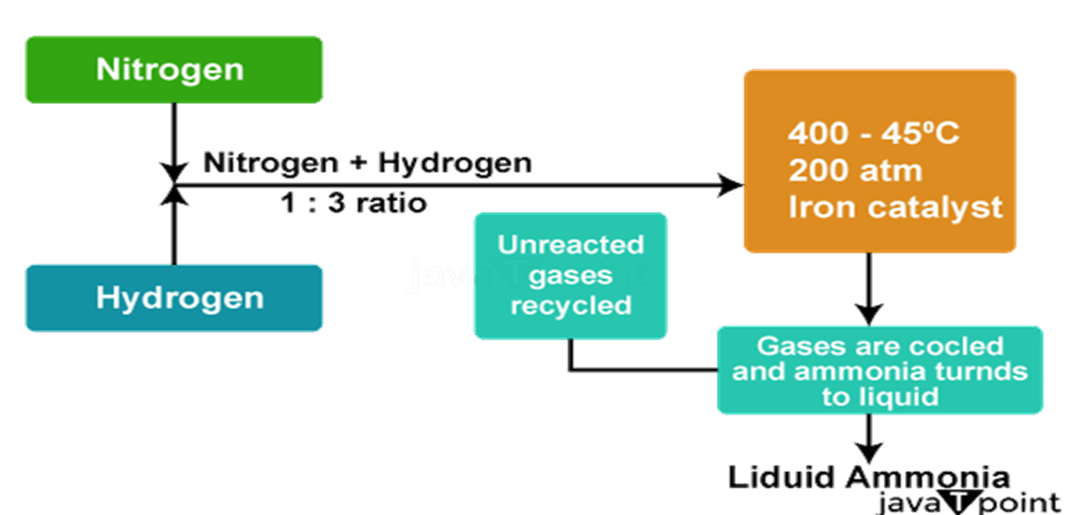Haber ProcessThe Haber process, called the Haber Bosch process, is the leading industrial process for producing ammonia from nitrogen and hydrogen. In this process, nitrogen from the air combines with hydrogen derived from natural gas methane (CH4). N2 (gas) + 3H2 (gas) --→ 2NH3 (gas) (Nitrogen) (Hydrogen) (Ammonia) 
The Haber process perfectly illustrates how industrial chemists use their knowledge to find the best conditions needed to produce a good yield of product (ammonia). The following are the raw materials required for the process-
Requirements for the Haber Process1. The Catalyst:The catalyst is slightly more complicated than pure iron. It has potassium hydroxide added to it as a promoter - a substance that increases its efficiency. Pure iron catalysts are not very effective. When used as a catalyst, iron always contains a small percentage of several other oxides like Al2O3, ZrO3, SiO2, etc. 
Mechanism of Catalyst
2. The Pressure:The pressure varies from one manufacturing plant to another but is always high. The minimum required pressure for ammonia production is 200 atmospheres. According to Le Chatelier's Principle, if there is an increase in the pressure, the system will respond by favoring the reaction, which produces more ammonia molecules. In order to get as much ammonia as possible in the equilibrium mixture, the pressure needs to be as high as possible. Two hundred atmospheres are the minimum required pressure.
3. The Temperature:

Steps of the Haber Process1) Hydrogen Production:Methane is the primary source of hydrogen. Hydrogen is obtained by reacting steam with natural gas. Hydrogen can also be obtained from cracking oil fractions. Following are the steps for hydrogen production.
2) Ammonia production:The technological improvement has resulted in significant improvement in the yield of ammonia. 3H2 + N2 → 2NH3 This step is known as the ammonia synthesis loop. According to the Le-Chattelier principle, ammonia production is favored by high pressure and low temperature. From the equilibrium data measured, it was obvious that the reaction temperature should be kept well below 300 degrees Celsius and pressure above 200 atmospheres to obtain a higher percentage of ammonia. 3) Recycling:At each pass of the gases through the reactor, only about 15% of the nitrogen and hydrogen are converted to ammonia. (This figure also varies from plant to plant.) The overall conversion is about 98% by continually recycling the unreacted nitrogen and hydrogen. The Kinetics of the Haber ProcessTransition metals are always used to catalyze the Haber process. The Haber process involves two important factors. An effective catalyst and a transition metal. The catalyst is said to be an effective catalyst when it can easily bind to nitrogen gas. Without the crucial binding of the catalyst, nitrogen remains inert and unreactive, producing no ammonia. The Haber process has been optimized extensively but still uses enormous energy. To cover this high energy consumption, quantum mechanics is used. It (Quantum mechanics) predicts the reaction mechanics and kinetics for NH3 synthesis on Fe (iron). Fe is the best catalyst for NH3 synthesis. High pressure is favored in the Haber process. Haber Bosch Kinetics typically operates at 400°C temperature and 150-250 bar pressure. The Reversible reaction is highly favored at higher NH3 partial pressure, which lowers conversion by 15% in a single pass, whereas recycling unreacted reactants increases the conversion to 97%. Overall, this is a remarkable conversion. The rate of uncatalyzed reaction is observed to be effectively zero. Therefore, the catalyst is required for the reaction to occur at an appreciable rate. Catalyst 1/2 N2 + 3/2 H2 --------------> NH3 Originally an osmium catalyst was used in the Haber process. Fe catalyst was used with Al2O3, K2D, CaO, and SiO2 on a FeO support. The catalyst particles consist of the inner core of magnetite (Fe3O4), a secondary layer of FeO, and an Outer Fe layer. The Thermodynamics of the Haber ProcessThe catalyst only affects the reaction's spontaneity. This is due to a fundamental aspect of physical chemistry: the kinetics and thermodynamics of a reaction often remain independent of each other. Though we may deduce that a highly thermodynamically favored reaction occurs faster than one less favored, exceptions exist. The Haber process is an exception, a reaction with favorable thermodynamics but incredibly slow kinetics. Aside from the spontaneity, it can also be observed that the reaction has an adverse change in entropy (Delta S < 0), specifically when four moles of reactant gas produce two moles of product gas. N2+ 3H2 -----> 2NH3 A reduction in the moles of gas indicates that the system has low energy, indicating decreasing entropy. It also justifies the negative change by indicating that fewer gas molecules mean more "disorder". The reaction must have a decrease in enthalpy for the reaction to be spontaneous despite the decreasing entropy. This is the case: The Haber process is exothermic (Delta H< 0). According to the definition of Gibbs free energy, spontaneity must increase as temperature decreases. Put differently, decreasing temperature makes Delta S less significant, making Delta G more negative: Delta G= Delta H-T delta S (In this equation, T indicates the temperature at which the reaction takes place) The next section mechanism of the Haber process will be discussed, which takes into account the transport, absorption, desorption, and exchange reactions. Mechanism of the Haber Process:The Haber process mechanism undergoes seven elementary steps for the synthesis of ammonia.
The sequential performance of each step is necessary for a good yield of ammonia. The first and last two steps that are steps one, six, and seven, are fast compared to the adsorption reaction and desorption reaction, steps four and five, respectively; this is because of the shell structure of the Catalyst. Various investigations have proved that the dissociation of nitrogen is the rate-determining step of ammonia synthesis. The exchange reaction between deuterium and hydrogen takes place at room temperature. Since the absorption of both molecules is rapid, it cannot determine the speed of ammonia synthesis. Apart from the reaction condition, the absorption of nitrogen on the catalyst surface depends on the microscopic structure of the Catalyst. Different Catalysts have different reactivity. For Example, Fe (III) and Fe (2II) have the highest activity reason being that only Fe (III) and Fe (2II) surfaces have C7 situs. [C-7 situs means these Catalyst surfaces have iron atoms with seven closest neighbors. In the Haber process, two operation envelopes carry out ammonia synthesis mechanisms. There are two operation envelopes; lower operation envelope and higher operation envelope. These operation envelopes are designed according to the processing plant. Based on these experimental findings, the reaction mechanism is believed to involve the following steps.
Reaction 5 occurs in three steps, forming NH, NH2, and NH3. Experimental evidence points to reaction two as being a slow, rate-determining step. This is not unexpected since the bond is broken; the nitrogen triple bond is the strongest of the bonds that must be broken.
Next TopicModes of Heat Transfer
|
 For Videos Join Our Youtube Channel: Join Now
For Videos Join Our Youtube Channel: Join Now
Feedback
- Send your Feedback to [email protected]
Help Others, Please Share









